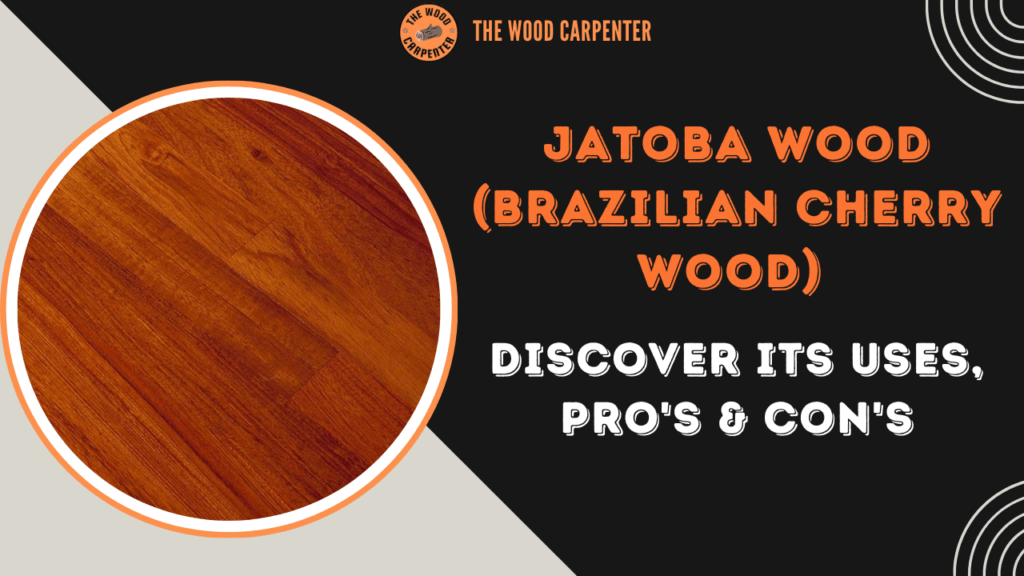
When it comes to exotic lumber, Jatoba wood (also known as Brazilian Cherry in the flooring industry) is an exotic Brazilian Cherry wood that not only is extremely durable. The deep reddish brown color that Jatoba is renowned for is what makes it so beautiful when finished.The wood is so hard that is is becoming widely used as flooring, furniture and even for heavy exterior work.
In this guide, we take a closer look at everything you should know about Jatoba wood; its properties, color and character, how it performs as a flooring material, what it has to offer, drawbacks, and how and where you can use it.
What Is Jatoba Wood (Brazilian Cherry Wood) ?
- Scientific name: Hymenaea courbaril
- Common names: Jatoba, Brazilian Cherry, Jutai, Locust, Courbaril
- Origin: Central America, southern Mexico, South America (especially Brazil), and the West Indies
- Despite being marketed as “Brazilian Cherry,” Jatoba is not related to cherry trees at all. The nickname came from its striking reddish tone, which resembles cherry wood after finishing.
Appearance and Color
- Heartwood is golden brown with a reddish hue turning to a dark red, Jatoba Wood is usually found with darker striping or alternating dark stripes. Its white to pale brown or pinkish sapwood is demarcated from the heartwood.
- Freshly milled Jatoba: lighter, orange-brown
- After exposure to light: darkens to a more intense reddish colour after the first months
- Outdoor weathering: if left untreated, it gradually turns a silvery gray, like many tropical hardwoods
- This natural color evolution is part of what makes Jatoba so visually appealing, though it does mean homeowners need to be mindful of uneven fading under rugs or furniture indoors.
Mechanical and Physical Properties
Jatoba is widely regarded as one of the hardest and most durable commercial wood species.
- Janka hardness: ~2,690 lbf — more than twice as hard as red oak
- Density: ~910–920 kg/m³ (about 57 lbs/ft³)
- Modulus of rupture (MOR): ~22,500 psi
- Modulus of elasticity (MOE): ~2.7 million psi
- Crushing strength: ~11,700 psi
- Shrinkage: radial ~4%, tangential ~8%
Such extreme hardness means that it is extremely durable and resistant to wear, that’s why you can see Jatoba for a flooring and heavy-traffic applications.
Durability and Resistance
This is one of the primary reasons that Jatoba has become such a popular wood around the world – its natural hardness.
- Highly resistant to rot and decay
- Naturally repels termites and insects
- It can withstand heavy loads and foot traffic
- Suitable for both indoor and outdoor applications
- Jatoba is a little less dense than other Brazilian hardwoods (such as Ipe or Cumaru), which makes it a bit easier to work with while still offering outstanding strength.
Workability and Finishing
Despite its density, Jatoba is workable when worked with proper tools.
- Machining: Tough on cutting edges – carbide-tipped tools recommended
- Planing: Cross grain, it may be prone to tear-out
- Gluing & Finishing: Works well—accepts stains, oils, and finishes well
- Bending: Responds well to steam bending
- The wood’s inherent glow also looks great with a plain finish that showcases its rich color.
Common Uses of Jatoba Wood
Because of it’s strength, beauty, and resistance to decay, Jatoba is used in many different areas:
- Flooring: Among the most popular exotic hardwood flooring choices throughout the world
- Furniture & cabinetry: With its rich red tones, it is a luxury furniture wood
- Exterior decking & siding: With proper finishing, it performs well outdoors
- Plywood & veneer: Often used in high-end paneling
- Industrial uses: It is used in railroad ties, tool handles, gear cogs, wheel rims, and ship building components.
It is this balance of stunning good looks and strength that makes Jatoba so extraordinary.
Advantages of Jatoba Wood
✅ Exceptional hardness and durability – extremely long-lasting
✅ Natural beauty – rich reddish hues that deepen with age
✅ Resistance to insects and decay – ideal for tropical and humid climates
✅ Versatile – works indoors and outdoors
✅ Affordable for an exotic wood – more cost-effective than Ipe or Teak
Challenges of Jatoba Wood
⚠️ Hard to machine – dulls blades quickly
⚠️ Heavy and dense – makes handling and installation tougher
⚠️ Color changes – darkens indoors; grays outdoors if untreated
⚠️ Movement in service – needs proper drying and acclimatization to prevent warping.
Brazilian Cherry Wood vs. American Cherry
| Feature | Brazilian Cherry | American Cherry |
|---|---|---|
| Hardness (Janka Rating) | 2,350 | 950 |
| Color | Reddish-brown, deepens with time | Light reddish-brown |
| Durability | High | Moderate |
| Water Resistance | Good | Moderate |
| Price | Expensive | More affordable |
| Uses | Flooring, furniture, stairs | Furniture, cabinets, veneers |
Brazilian Cherry Wood Price
The Brazilian Cherry wood price depends on lot, grade, and resistence..
- Cost of flooring: $5 – $9 per square foot
- Cost of Furniture: Over $1000 for high end.
- Cutting Boards: $30 – $80
Prices prices may vary depending upon market demand and availability.
Sustainability and Availability
It is found throughout Central and South America and is not listed in the CITES appendix. It is also rated as Least Concern by the IUCN Red List.
So which makes Jatoba what one might call relatively sustainable (although, it really does depend on whether it’s being harvested responsibly or not). It can also be found in lumber and floor plank products.
Maintenance Tips
To keep Jatoba wood looking its best:
- Indoors: Rotate rugs and furniture to avoid uneven darkening
- Outdoors: Apply UV-resistant oils or sealers to maintain its rich color and prevent graying
- Flooring care: Regular sweeping and cleaning protect against scratches; refinishing can restore original luster after years of wear.
FAQs About Jatoba Wood
1. Is Jatoba a good wood for flooring?
Yes, Absolutely Jatoba is one of the hardest species for flooring you will come across and it is very dent and wear resistant.
2. Why is Jatoba called Brazilian Cherry?
Name comes form lustruous red color, but it has nothing to do with cherry tree.
3. Is Jatoba stronger than oak?
Yes, it’s over two times harder than red oak, so it is much more durable.
4. Can Jatoba be used outdoors?
Absolutely. With proper sealing, it works well for decking and siding.
5. Does Jatoba wood change color over time?
Yes, it does darken with light indoors, and outside turns grey if left unfinished.
Final Thoughts
Jatoba is a fast growing hard wood that is becoming popular in the UK due to its strong natural beauty and flexibility. Whether you are looking for upscale, on the floor, in the garden, on the roof or in the garden of your furniture, the extreme hardness in the structure of Jatoba makes it the perfect, long-lasting product for any construction.
With it’s stunning deep red colour, incredible hardness and much lower cost than many other exotics it’s easy to see why it appeals when people want to make a statement in the great outdoors.
For those looking to strike the balance between stunning good looks and long-lasting durability, Jatoba is the perfect hardwood, sure to please for years to come.

